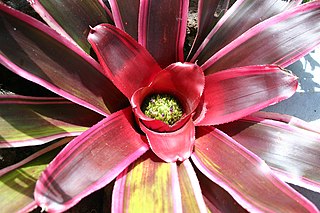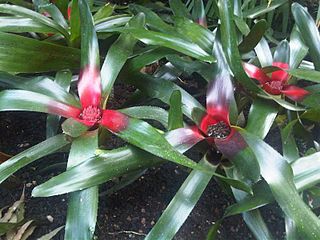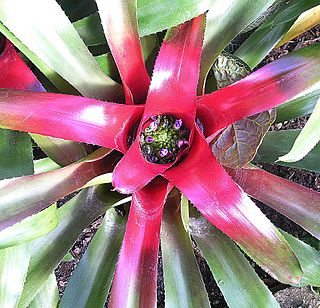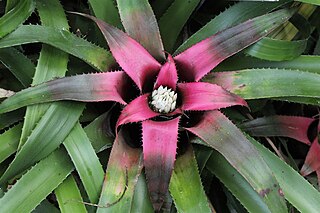
Neoregelia is a genus of epiphytic flowering plants in the family Bromeliaceae, subfamily Bromelioideae, native to South American rainforests. The genus name is for Eduard August von Regel, Director of St. Petersburg Botanic Gardens in Russia (1875–1892).
Neoregelia wilsoniana is a species of flowering plant in the genus Neoregelia.

Neoregelia compacta is a species of flowering plant in the genus Neoregelia. This species is endemic to Brazil.

Neoregelia coriacea is a species of flowering plant in the genus Neoregelia. This species is endemic to Brazil.

Neoregelia correia-araujoi is a species of flowering plant in the genus Neoregelia. This species is endemic to Brazil.

Neoregelia cruenta is a species of flowering plant in the genus Neoregelia. This species is endemic to Brazil.

Neoregelia cyanea is a plant species in the genus Neoregelia. This species is endemic to Brazil.

Neoregelia farinosa is a species of flowering plant in the genus Neoregelia. This species is endemic to Brazil.

Neoregelia johannis is a species of flowering plant in the genus Neoregelia. This species is endemic to Brazil.
Neoregelia laevis is a species of flowering plant in the genus Neoregelia. This species is endemic to Brazil.

Neoregelia macrosepala is a species of flowering plant in the genus Neoregelia. This species is endemic to Brazil.
Neoregelia marmorata is a species of flowering plant in the family Bromeliaceae. It is endemic to Brazil.
Neoregelia melanodonta is a species of flowering plant in the genus Neoregelia. This species is endemic to Brazil.

Neoregelia spectabilis, the fingernail plant, is a species of flowering plant in the family Bromeliaceae, native to the South Brazilian rainforest. Growing to 40 cm (16 in) tall by 80 cm (31 in) wide, it produces rosettes of up to 30 red-tipped strap-shaped leaves, the inner leaves coloured red; and, in summer, blue flowers with red or purple bracts.
Neoregelia zonata is a species of flowering plant in the genus Neoregelia. This species is endemic to Brazil.

Neoregelia olens is a species of flowering plant in the genus Neoregelia. This species is native to Brazil.
Neoregelia pineliana is a species in the genus Neoregelia in the bromeliad family. This species is native to Brazil.

Hylaeaicum is a genus of flowering plant in the family Bromeliaceae, native to tropical northern South America. The taxon was first described by Ernst Heinrich Georg Ule in 1935 as a subgenus of "Aregelia". It was later treated as a subgenus of Neoregelia, before being raised to a full genus in 2021, a status accepted by both Plants of the World Online and the Encyclopaedia of Bromeliads.

Neoregelia subg. Neoregelia is a subgenus of the genus Neoregelia.

Neoregelia subg. Longipetalopsis is a subgenus of the genus Neoregelia.













